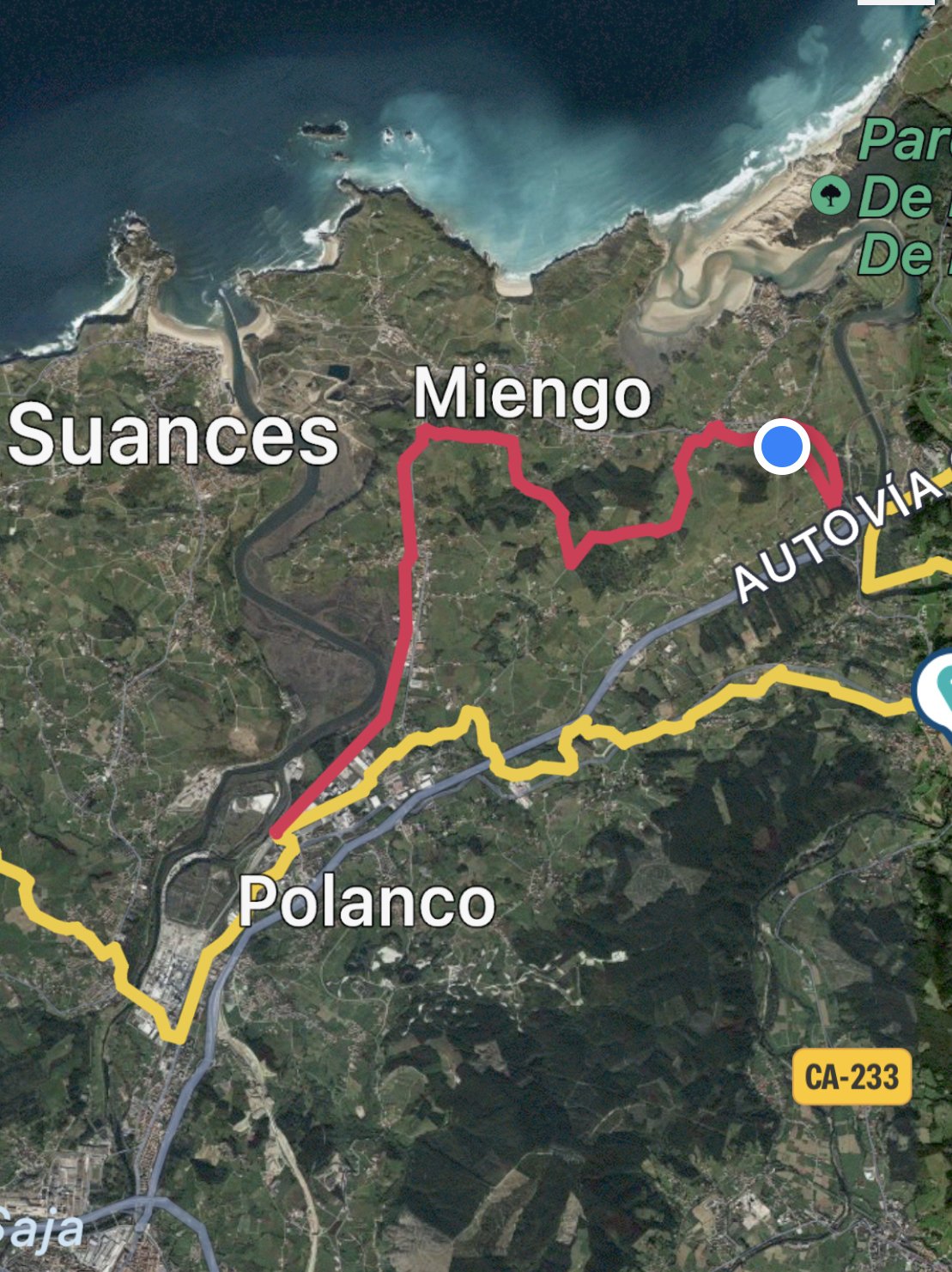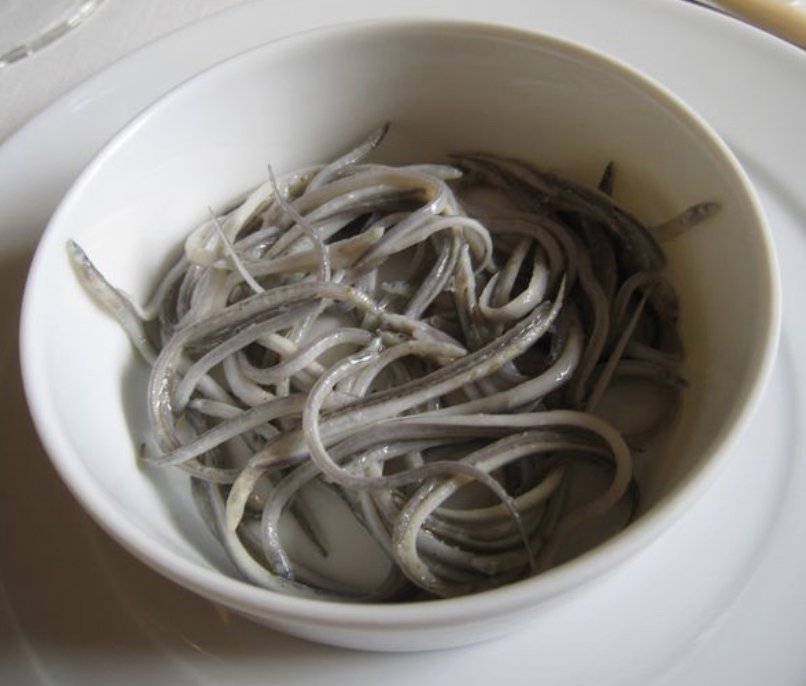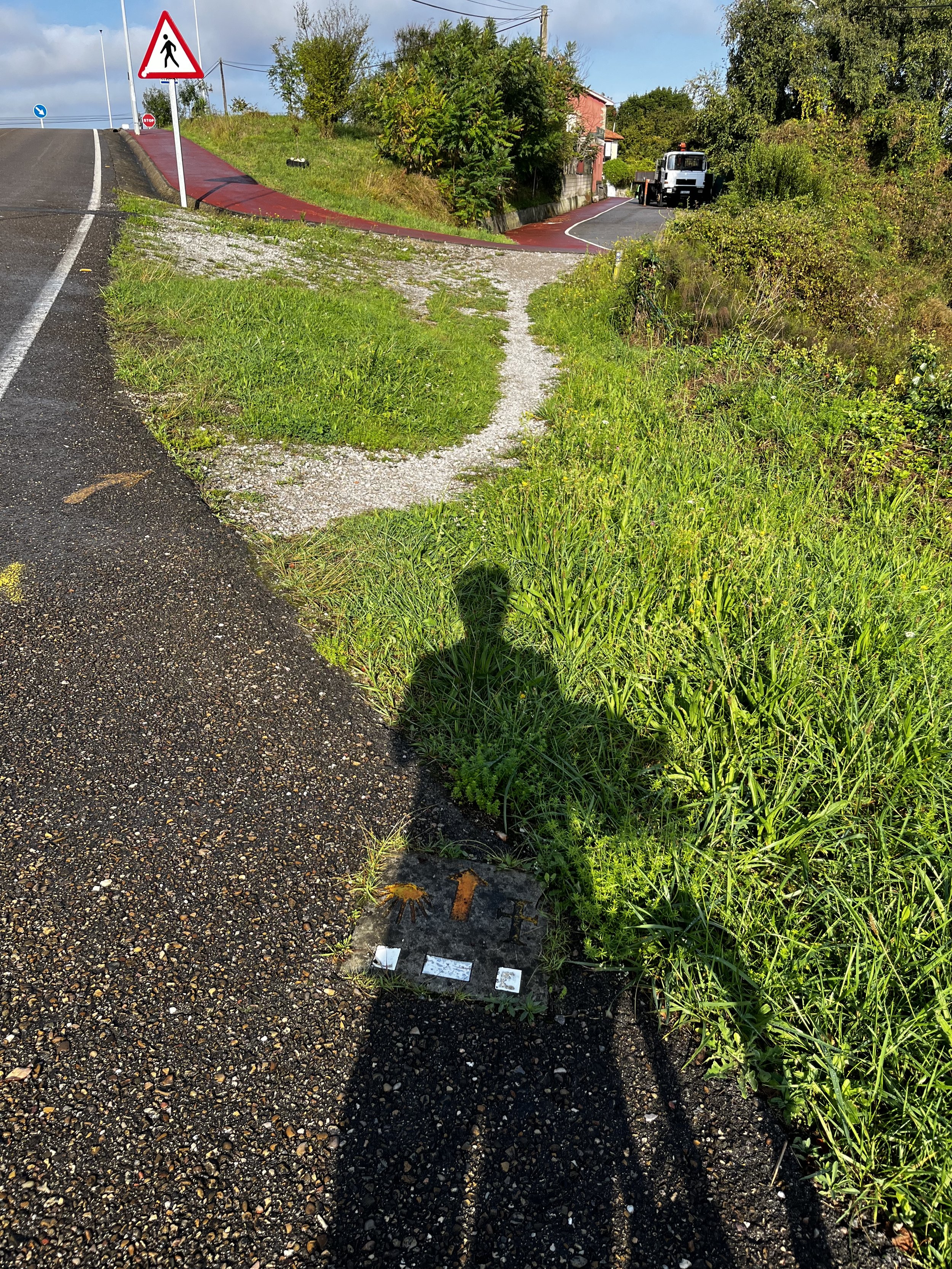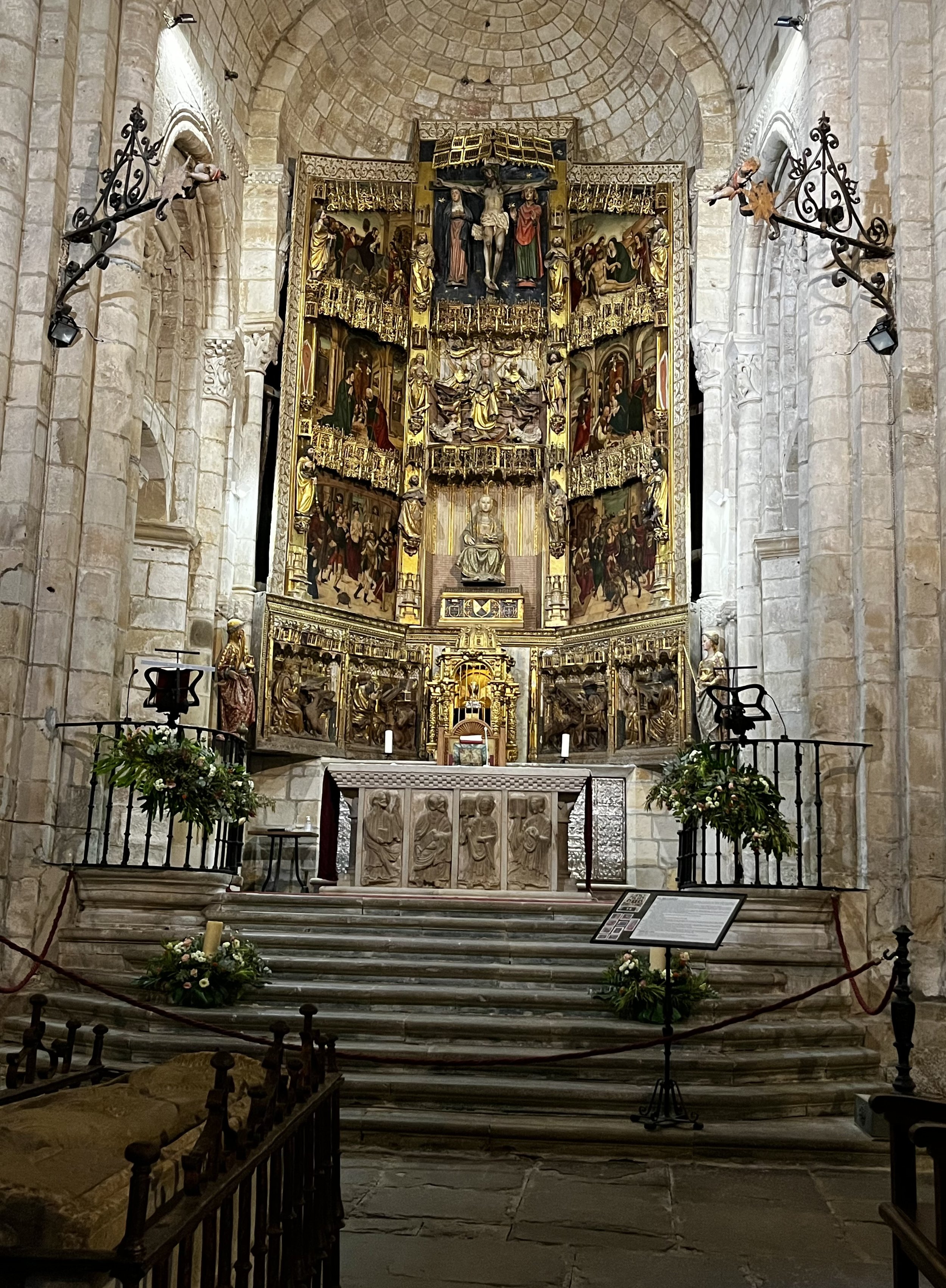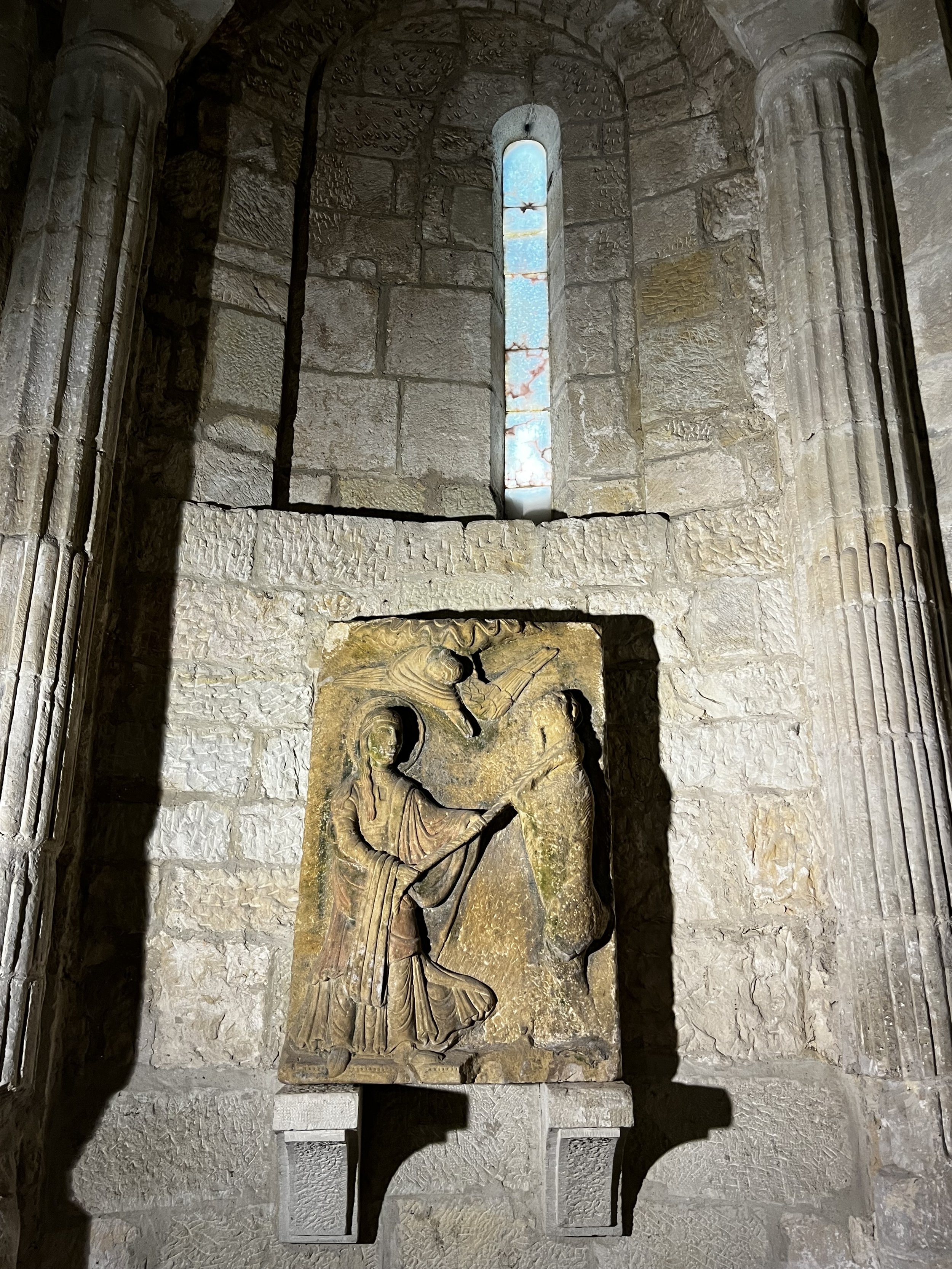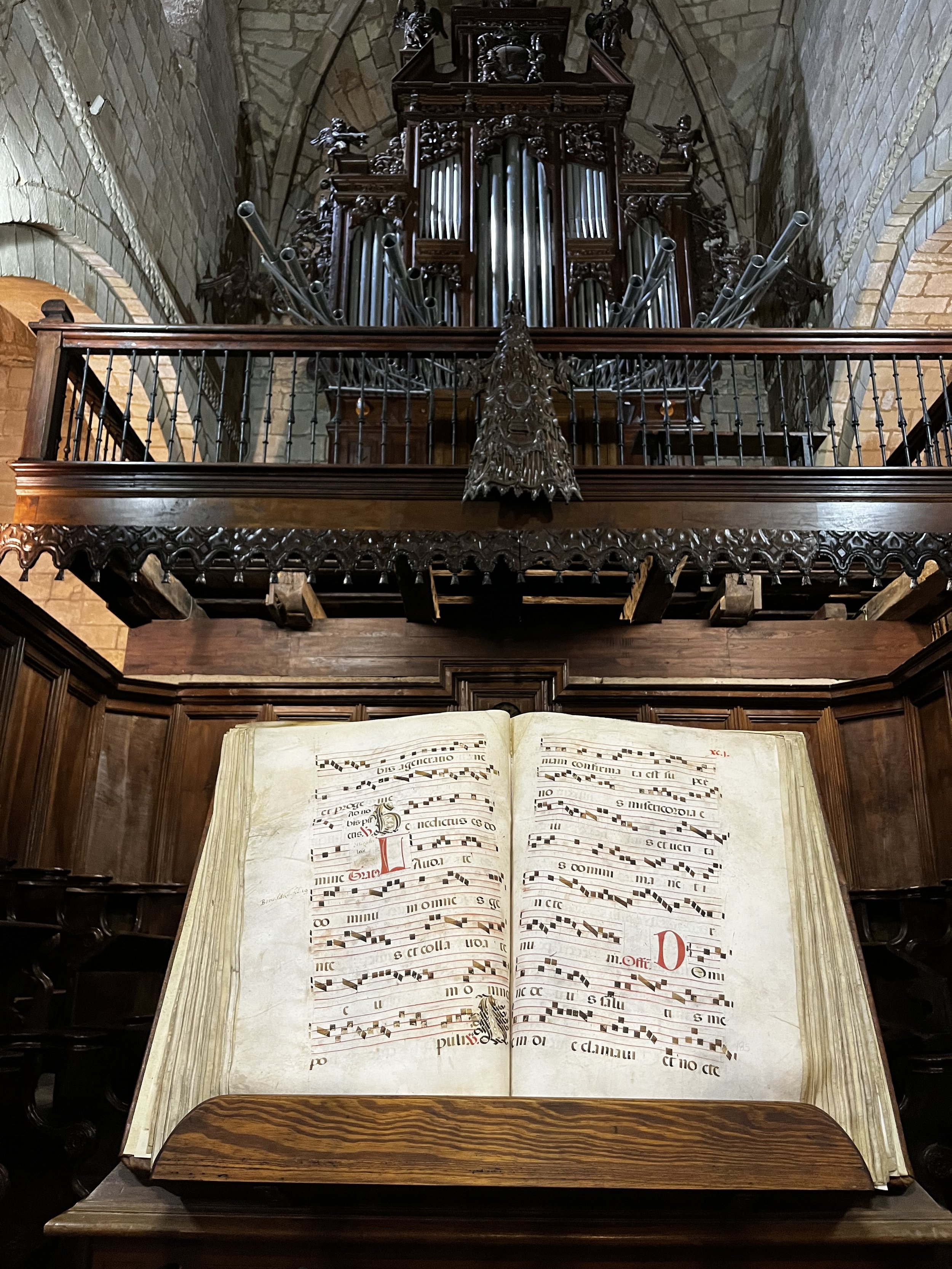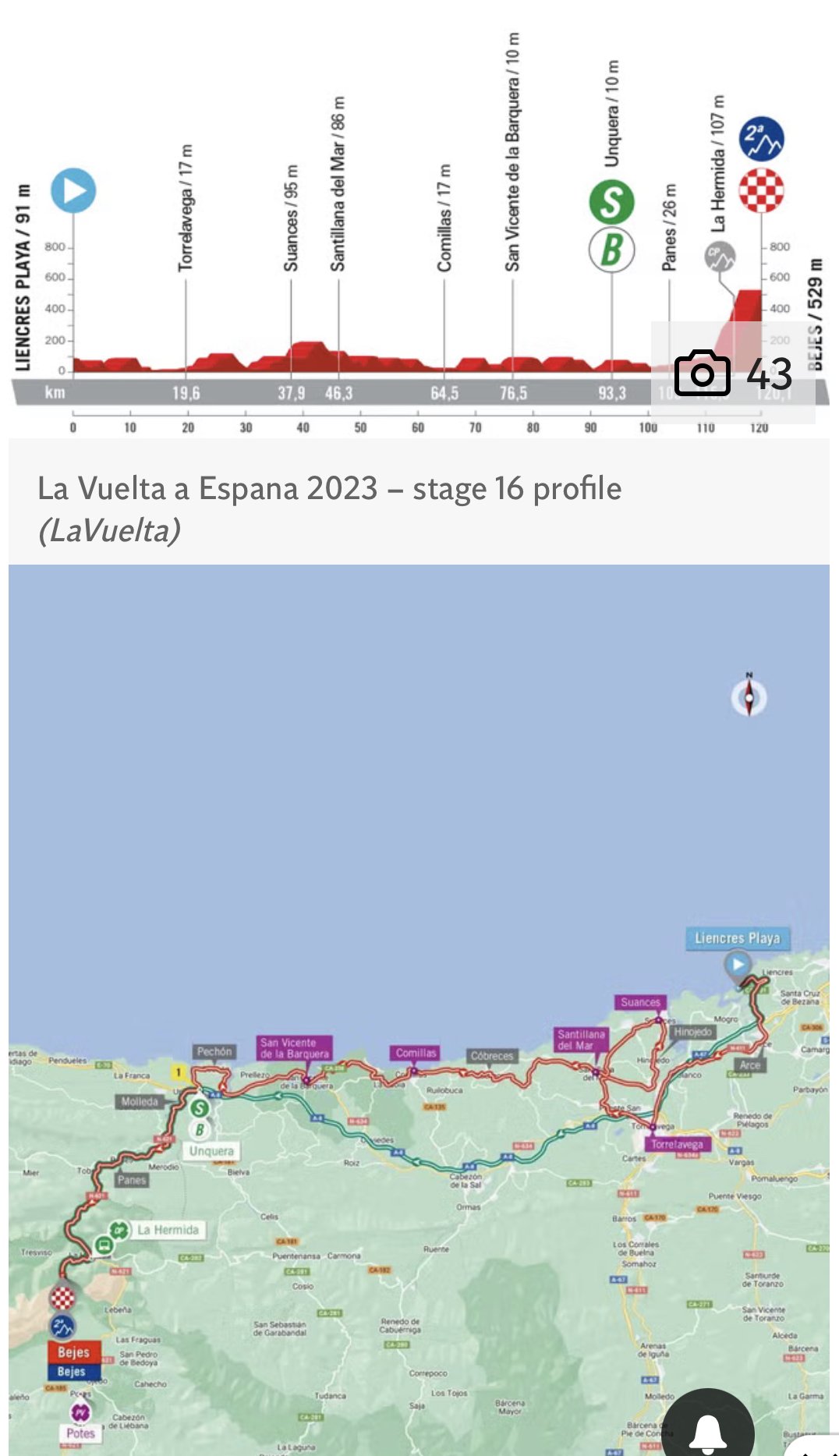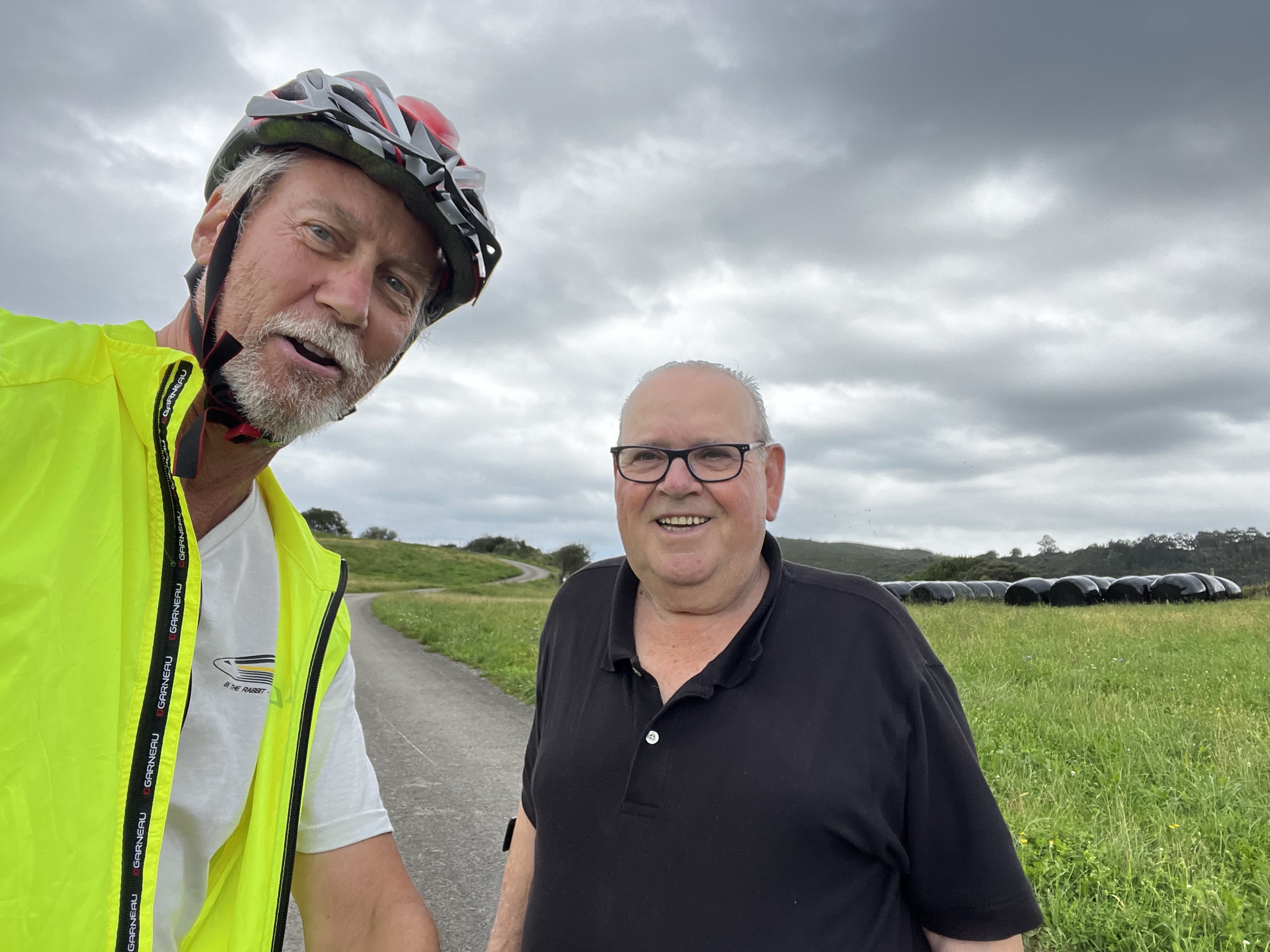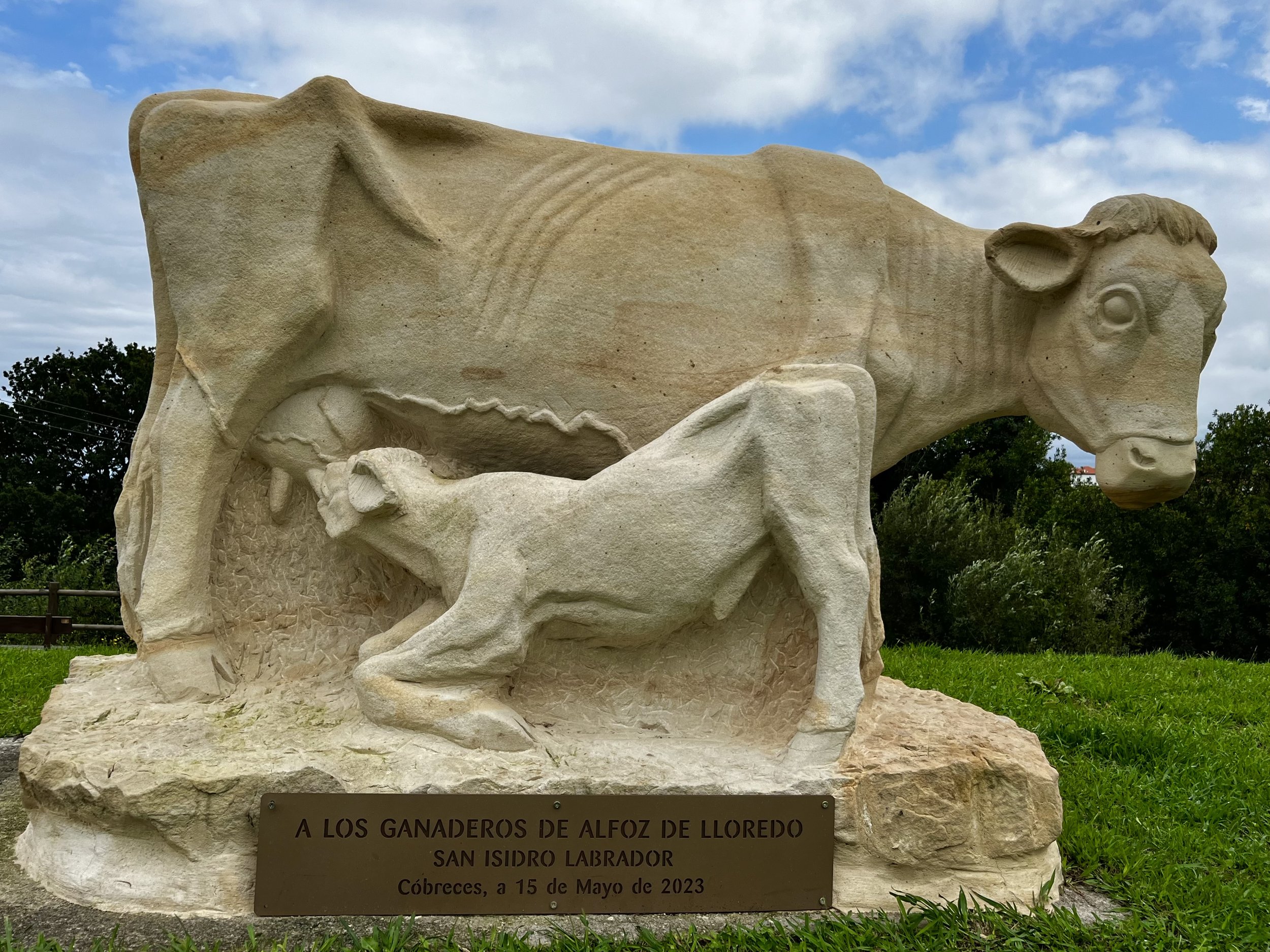Day 8 to Comillas
11 September 2023 Day 8 was a 42 km day
A special treat awaits me today at the little village of Santiillana del Mar en route to todays destination of the awesome town of Comillas
Yellow is Camino Route, Red is bicycle variant
As can be seen from this map, the blue dot is where I spent the night in Mogro at a very nice Posada overlooking a valley but to get there I had to cross a river and one would say that there’s a short hop from the yellow line to the red line. But do you see the words AUTOVIA - this is the A67 - that means it’s a freeway (multi-lane interstate in the US) and it would be extremely dangerous to try to pull that off to save a handful of kilometers -two double lanes of traffic moving at high velocidad, indeed.
On a positive note, the red line is part of the official Camino (bicycle and foot) and it is right outside my door confirmed by a single Camino tile that I saw embedded in the sidewalk, showing the scallop and there was an arrow outside the restaurant I left. It is an alternate route that walkers or bikers can take, and as you can see, it will lead me back to the main Camino yellow line heading west as always at Polanco. These variations are due to the fact that modern roads often overlap the ancient camino trail and private land rignt of way don’t always prevail in modern times.
I have been so fortunate with the weather ! In the middle of the night it did rain with thunder and lightning on and off. There is sprinkles right now, but they say it does not start until nine so I have an hour to spend thanking about today’s route in the next three days after today, which will be strenuous. I dug out my rain jacket and will have it handy as I’m sure it will sprinkle. It might rain part of the day today, but you never know. On my last Camino my rain jacket turned out to be a good luck charm that warded off the llueve!
On a positive note, even though I tossed and turned all night, I do have an appetite, and I’m looking forward to a moderate quantity of calories.
That will agree with me.
At last!
It also gives me time for a short story about last nights dinner well, I had a low appetite. I know I had to get something in the gas tank no matter what, so I walked downhill to the (recommended) restaurant El Estación that was within walking distance I was able to read half of the manual. Unfortunately they did not have rice or paella which I knew would agree with me as it is gentler on the stomach and has some calories to it. I ended up ordering Camerones corn ajilo but I did not notice that it was kind of come with angulas. It came to the table and a nice bowl, boiling in butter, which my first thought told me would kill anything biological in it therefore it would be audible with a degree of safety. However, I have a faint memory of what I angulus are and they made my stomach turn a little bit and I do not eat them even though they are a big time Basque delicacy if the angulas were real versus mock, they sell for about $500 a pound. Therefore these must’ve been fake ones which are made with, a fish like pollock, and then extruded and colored to make them look like the little sea eels. Add one piece of bread and seven of the nine shrimp tails and call it a night. Unfortunately, while I still am recovering, I cannot be adventurous to eat that whole dish because it would’ve been, I’m sure, very, very yummy. (some weird image of those little eels coming to life in my stomach I guess - that’s what you get from watching too much ‘Twilight Zone’ as a kid
So, What are Angulas?
Angulas are baby eels, known as elvers in English, and they're a pale, 3-inch-long, worm-shaped seafood that happens to be a big time Basque delicacy.
Angulas are the offspring of the common Atlantic eel, which are born in the Sargasso Sea, in the part of the Atlantic Ocean that roughly corresponds with the Bermuda Triangle.
The baby eels drift eastward on the ocean currents, winding up in the freshwater estuaries of Spain some three years later, where fishermen scoop them up.
These on my plate turned out to be mock angulas called gulas made from a fish like pollock, same as it is used in mock crab. These were the base of my shrimp dish with sautéed garlic slices all served in boiling butter. I’m sure in the whole thing would’ve been fabulous. I just couldn’t handle eels after being eel 😷 pun intended 👻 ____
Note: please forgive voice transcription errors, formatting errors, and some grammar issues. I don’t always catch them on the fly as I am updating the entire website on an iPhone during the siesta I take right after I am done riding for the day. Additionally, the ability to put captions directly on the pictures is not working so I add a text box underneath to capture my thoughts, as was the case on my last Camino, I will endeavor to clean up the website this winter after a very long siesta this fall … my goal right now, is to get images in the correct order of occurrence and immediate thoughts and impressions associated with the moment. (embellishment to occur at a later date.)
I never pass up my early morning rocket fuel (with cafe con leche) ritual
The day started delightfully, in spite of what I would consider a late start because breakfast -was not served until nine earliest, with a recovering tummy), I had what is arguably the very best croissant I’ve ever had in Spain, bold statement, but I can back it up! It was so light, if it wasn’t for the honey glaze on top, it would’ve absolutely floated away out the window.
That along with the ubiquitous, ham and cheese offerings always present at breakfast, enabled me to make a toasted, ham and cheese sandwich on artisan grain bread -my appetite, not fully back- I limited myself to one, but I did have a second piece of that great bread with orange marmalade. Top that off with an orange juice and a café con Leche I figured I had enough gas in the tank to start riding.
The drizzle only lasted five minutes which was nice.
I still struggle with paying attention to signage during the day, especially in the morning and often take wrong turns at junctions and cross roads. There are two indicator signs in this picture below. Do you see them and remember I am often cycling at 7 to 10 km/h trying not to hit things like trail bollards or go into the gutter
Yup, go right
Note small white post upper right with small yellow ‘flecha’
There are three sign indicators in this picture, and I almost blew by this turn as well. I would absolutely love to know the number of those that are able to navigate a full Camino Norte without a guidebook, GPS, or app without making a single wrong turn or getting lost- I would venture to guess that the number is 1% or less. Back in the day, I assume you would simply ask one of the locals, and they would turn in point in the direction! Even with wrong turns, heading west will eventually get you back on track.
Gee what a concept
Entrance to the beautiful (touristy) 8th century cobblestone paved town of Santillana Del Mar
There is an old saying that Santillana del Mar is The Town of Three Lies, since it is neither a Saint (Santo), nor flat (llana), nor is it by the sea (Mar) as implied by its name. However, the name actually derives from Santa Juliana (or Santa Illana) whose remains are kept in the Colegiata, a Romanesque church and former Benedictine monastery. Santillana del Mar is a town in the Cantabria region of northern Spain. It’s known for its medieval towers, Renaissance palaces and the Romanesque Santa Juliana Collegiate Church.
This Cantabrian town houses its greatest treasure on the outskirts: the Altamira cave (dating from 35000 years ago), known as the “Sistine Chapel of the Paleolithic Age” discovered in 1868 and declared UNESCO World Heritage site due to contents featuring charcoal drawings and perfectly preserved polychrome paintings of local fauna. I did not know this as I passed through and consequently did not go to see this famous site.
The Main Street thru town is lined with artisan shops. A lot of leather goods, nick nacks and foods - cheeses, chocolates, meats, candies. This shop was full of home made jams, preserves and jellies….this sign alone has over 60 varieties listed ! On the bicycle I just didn’t have the (weight) capacity to buy anything….. once again this town would be worthy of a re-visit with my esposa some time in the future.
Santillana del Mar Collegiate Church, Santillana Del Mar, Espana
Wow, what a really cool little town that showed up out of nowhere!, (worthy of a side trip if you are in the area (yes it’s more than a little touristy, but the church was worth a stop alone) cobblestone streets, shops lining both sides, cafés, and bars you name it just beautiful. I walked my bike because cobblestones and biking don’t always agree with me.
Well, the majority of the Capellas, hermitages, and churches are closed with the exception of Sundays. This world UNESCO site was open! So I paid my 5 euro, got my sello (stamp) and went in.
I discovered that the cloisters were open for tour as well as the sanctuary, I was also able to get a stamp here to continue to document my progress on the Camino Del Norte as required daily.
Unbelievable hymnal with gorgeous musical scoring ! Clearly not off the printing press. This is a one of a kind. Such beautiful hand lettering.
The organ appears to have been commissioned and built in the 1700s which is just incredible. I could not get anyone, including the staff who was collecting for admittance to tell me when the next Bachs toccata and fugue in D minor recital will be !
The rest of the building goes back way way back, and I stated before due to its historical significance was added as a UNESCO world heritage site.
12th century cloisters
Historical: Santillana del Mar Collegiate Church has its origins in a monastery dating from 870. Tradition has it that it was home to the relics of Santa Juliana. Remember, that the Camino Primitivo began around this time near 970
Over the course of the 11th century it was transformed into a collegiate church, although the building visible today dates from the 12th century. It has three naves, with dome, transept, three semi-circular apses and a tower. The transept and apses conserve their original barrel-vaulted ceilings. Special mention should be made of the sculptural decoration of the doorway, the capitals and the cloister. Inside you can see medieval tombs and Romanesque reliefs from the 11th and 12th centuries
Juliana of Nicomedis, wherever that is, is said to have suffered martyrdom in the year 304, and somehow her bones or remains now politely referred to as relics have showing up here.
Her box is in front of the altar, I assume
I had to push my steed up the paved street until I got to this camino path. Still uphill but manageable on my trail bike
Out of town, pavement gave way to gravel. Gravel gave way to gravel path single track as we call it. My mountain bike steed, a Megamo Natural model 11 speed (Deore drivetrain ) mountain bike performed well and once again, I was thankful for mountain bike tires, which are much more puncture resistant than gravel or other tires. I really don’t wanna have to replace a tire even though I carry 2 spare tubes and tools along with two different ways to inflate them, flat tires are considered routine maintenance are not included with the bike warranty for the trip. In other words, they don’t come out to replace the tire. I’ve replaced many on my own, however, and can do it in about 10 minutes. Fortunately such skills were not required on my Camino of 500 riding kilometers.
_____________________________________
So as I’m cruising through the Catabrian countryside, I hear behind me the harmonic resonance of sixteen carbon racing bike wheels coming up the hill behind me. Carbon wheels which can often cost $500-$1000 each make a characteristic drone when riding on pavement. I wasn’t quick enough (to say the least) to get out my phone and take a picture as they breeze by me -eight guys all on a identical S-Works racing bikes all in identical jerseys and being followed by a support car to keep them safe and up and running in case of breakdown. When I got checked in at my hotel, I asked the concierge. Hey what do you know about what’s going on with cycling around here ? Well, something very interesting IS going on as I speak - the 2023 La Vuelta de Espana ! is going on right now (month long event with approximately 27 racing days - each stage on a different area of Spain)
AND They will be passing through the town I am staying in tonight - Comillas- but I’m not sure I’ll be here to see them whizz by tomorrow mid day unless they happen to be riding part of the Camino that I am on - doubtful as I’m sure they have roads blocked off for these guys.
FACTOID: The theme of the 2023 Vuelta a España is climbing, (and it’s going on as I speak through northern Spain ! ) with only three truly 'flat' stages - 7, 12, 19 and the final day in Madrid, and punishing ascents such as the Col du Tourmalet in the same day as the hors categorie Col d'Aubisque, Col du Soulor and Col de Spandelles, and a short but frantic stage finishing on the brutally steep Altu de l’Angliru. In addition to the team time trial, and the flat stages. the 3153.8km route also includes two flat stages with high-altitude finales, six hilly stages, seven mountain stages and one individual time trial. They start in Barcelona and finish in Madrid.
By comparison, my stages are a max of 50 km there’s are north of 180km in a given day. I will complete 500 km in all and you can see that’s a mirror fraction of what these men and women are doing. One stage consists of over 4,000 metres of elevation gain over 135km and will not offer a single kilometre of respite. My worst stage had an awful climb of almost 400 m of which I pushed my bike up the entire hill. 😵💫👻💥
An American goes on to win the overall general category! Sepp Kuss has sealed his Vuelta a Espana triumph.
Kuss enjoyed the ceremonial ride into Madrid as he became the first American to win a Grand Tour since Chris Horner at the same race 10 years ago. Way to go Sepp!
Stages of the Vuelta. You can see the 12th and 13th September overlap with my Camino ‘tour’
Warmup riding prior to todays stage of La Vuelta
How cool is that?! they’ll come flying through Comillas tomorrow sometime I wonder if I will see them anywhere along my route but like I said I doubt it I think the roads blocked off. I’ll see. Their stage 16 today was a wimpy 120 km run at average speeds north of 30 km/hour !
It was along this route, where I happened upon a newfound friend in Spain as I took this picture. His name is Rogelio Gonzalez (de Arroyo). It was very enjoyable to get acquainted. I was asking him if he was walking into town, and he explain to me he walks as far as he can, but some days it’s not far because of a knee replacement and his arrhythmia. He was proud to tell me that he does own a bike and likes to ride it but not right now. His knee is recovering. He gave me a very good bite advice for biking, finishing my Camino, and life general as well. “Poco a poco” paco a paco”! He’s a very happy man, and been happily married for 42 years. He and I both lamented, that people don’t seem to stay married very long anymore five or six years and they move on he said. Rogelio added to my joy of Camino today !
Rogelio Gonzalez (de Arroyo). “Poco a poco” paco a paco” = good wisdom
A little more pavement (tarmac as they say over here) riding but not a problem because it’s a brand new ribbon of tarmac, and it is so beautiful to ride on. Up this hill down the other side to a beautiful little beach before my last cruise into Comillas (at last)
Some surfers out, and one lady out for a swim, but it looks like a pretty dangerous undertow situation. I pulled over at a bar for another Coke seriously over priced as in the 8 ounce bottle for $2.80. €. I chose not to eat lunch there accordingly knowing I was taken advantage of. Average price is 1 €
Just a little roadside chapel, with an offer of a sello / stamp for my pilgrim passport, so I took advantage of it, and received in return in the silence the following message “do this in remembrance of Me”
I always enjoy and look for receiving such impressions.
A walking peregrino popped in so I left giving him to his private moment of contemplation
I doubled back to take a picture of this fig tree, obviously very very old, supported by 11 branch supports. Prolly where the expression low lying fruit came from. Go fig-ure 👻
Leche; the udder cola! This region of Spain is famous for artisan cheese production and the lowly vaca (cow) is duly celebrated!
Since I somehow missed lunch and all of the restaurants and bars closed at five, (mistake) I went to the (tiny) Supermercado and got a premade (guaranteed safe food) salad, some nuts, two carrots and then went across the street to a cheese and chocolate and meat shop and got some specialty blue cheese, (There had to have been a hundred ‘rounds’ of cheese to choose from.) which is my all-time favorite variety as many know to embellish the salad. I bought Picón Bejes-Tresviso.
WOW was this good. I settled on one that was 25 Euro a kilo but I only bought a small slice.
Best blue cheese I’ve ever had !
Fun Queso Trivia:
Picón Bejes-Tresviso is a blue cheese from Cantabria, in the north of Spain. It has been protected under Denominación de Origen (DO) legislation since 1994, prior to which it was traditionally known as Picón de Tresviso and Queso Picón de Bejes. The designated area centers in the Liébana valley and production is restricted to municipalities.
Source of milk a mixture of sheep's, cow's and goat's milk. So this is why, after I’ve had it for two meals it’s not only way good it is in fact whey, whey, whey good
Acidity values in the fat content of the cheese have been shown to increase by a factor of twenty over the uncured curd.
The curd pieces are placed loosely in the mould, allowing sufficient air to circulate and initiate the growth of penicillium spores. (recovering from food poisoning. This is very reassuring. Now I don’t have to go to the farmacia. Even at €25 a kilo my slice only cost me three bucks to add to my grocery store salad.
Governing regulations stipulate that final maturity be achieved by further curing in a natural limestone cave, typical of the geology of the Liébana region, for a minimum of two months. It’s going to be in the limestone, right?!
Favorite moment of the day: the whole day, it was just plain a great day of riding and watching the world go by and ending up in a fantastic town, famous for the following;
Comillas: The town of Comillas is one of the northern Spanish region of Cantabria’s most symbolic places and one of its most interesting from an architectural point of view. Once home to Spanish royalty.
The Comillas Pontifical University which is now a college campus of technological education of seven schools and disciplines - law, divinity, engineering, nursing. Neo-Gothic buildings abound.
It has some of the most important Art Nouveau buildings in Cantabria, which include Sobrellano Palace Chapel and the Pantheon, the Pontifical University and, of course, the brilliant El Capricho by the Catalan architect Antoni Gaudi. Unfortunately, I was just too plain tired to go into any group tours I rationalized by deciding I didn’t wanna chance being in groups catching the Covid.
______________
“I am convinced that pilgrimage is still a bona fide spirit-renewing ritual. But I also believe in pilgrimage as a powerful metaphor for any journey with the purpose of finding something that matters deeply to the traveler. With a deepening of focus, keen prepartion, attention to the path below our feet, and respect for the destination at hand, it is possible to transform, even the most ordinary journey into a sacred journey, a pligrimage.”
~ Phil Cousineau

